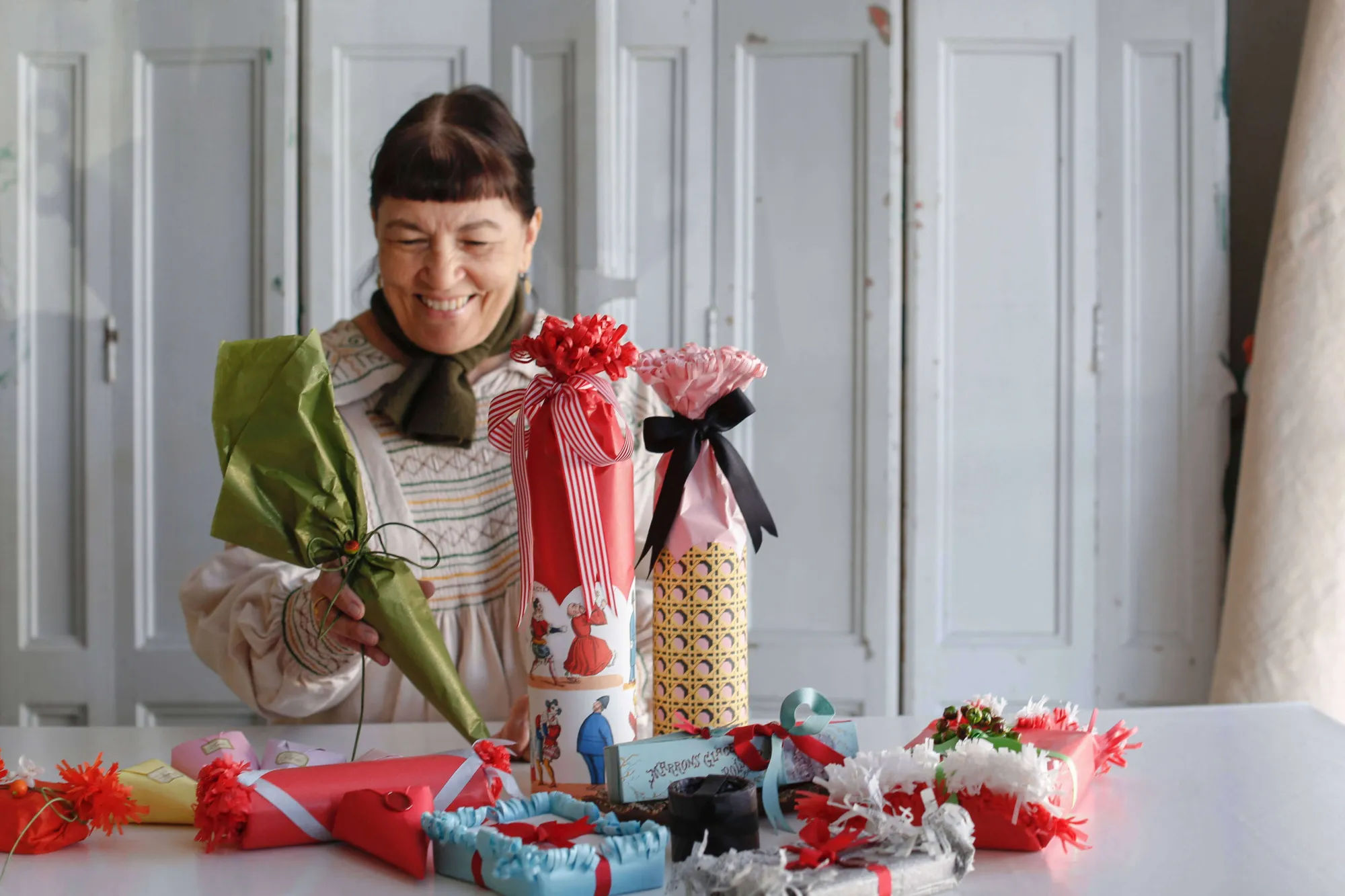
Claudia Schwartz, the proprietress of Bell’occhio, a whimsical boutique on a tiny lane off Market Street in San Francisco, is a bona fide expert on the presentation of the gift.
Photography by Leslie Santarina for Remodelista.
She teaches gift-wrapping classes several times a year ($125 for a three-hour class, sparkling wine and worldly treats included), and in the back room of her shop come mid-December, baskets full of gifts are stacked high, all awaiting Claudia’s touch before decamping by post (often to the famous and the fabulous).
Festive Wine Bottle Wrapping
A whimsical presentation for a wine bottle wrapped in tissue paper and topped with a French striped taffeta ribbon, English toy-print paper, and a hand-calligraphed Joyeux Noël card by the shop’s resident scribe Wendy Cook.
A note on scissors: Many of Claudia’s wrapping techniques rely on Fringe Benefits scissors ($22), made in France of stainless steel.
Materials:
As with all things Claudia, there’s a story here: On a trip to France years ago, Claudia found some vintage French candy wrappers with fringed edges and bought up the lot.
Step 1: Fold the edge of a pile of tissue paper so it extends beyond the top of your bottle by a few inches.
Step 2: Use the fringing scissors to cut the top edge of the paper pile into an approximately 2-inch fringe.
Step 3: Cut the decorative paper into a strip about 7 to 8 inches wide and long enough to wrap around the circumference of the bottle. If you visit Claudia at her shop in San Francisco, ask for a free scallop template when you purchase decorative papers.
Step 4: Wrap the tissue paper around the bottle, leaving the glass bottom exposed. Claudia uses a clear sticker (like these) to hold the tissue and scalloped jacket in place.
Step 5: Firmly bunch the tissue paper around the neck of the bottle, then fluff the fringe so it looks like a rosette on top.
Step 6: Tie a ribbon around the neck, then trim the ribbon ends à la Schwartz: fold the end of each bow tab in half, and cut a curve on the diagonal about an inch deep.
The packaging can be used again and again (just save it once you’ve removed it).
Jovial Fringed Ends
Like Santa Claus wrapping paper, but exponentially more sophisticated.
Materials:
Step 1: Fold (or cut) a pile of tissue paper to approximately fit your box, leaving ample width for open, fringed ends on each narrow side.
Step 2: Wrap the pile of tissue paper around the gift, just as you would an ordinary present.
Step 3: Wrap a single, long piece of ribbon around the gift, starting with the closed edges and ending with the fringed sides. Wrap the ribbon right over the fringed ends, securing the open ends with the ribbon.
Step 4: After the bow is tied, trim the tabs on a curved diagonal (as illustrated in the wine bottle wrapping, above).
“There’s no right or wrong way to do this,” says Claudia; she lets spontaneity be her guide.
Claudia invented a clever use for the ribbon scraps lying around her store: She ties the ribbons together end-to-end to make two-toned bows.
Two-Toned Bows
Step 1: Cut two pieces of ribbon, each a different color, and each a little more than half of what you’d need to tie a complete ribbon around the box.
Materials:
Step 2: Rest the knot somewhere intentional on the gift—it will function as a small “bow.” Then, tie the ribbon as you would any other.
Step 3: Claudia wrapped the ribbon off-center and tied the loose ends into a large bow.
Claudia with a pile of freshly wrapped gifts, plus some classroom examples and items packaged just for the shop.
More Ideas
Among the Claudia-wrapped treats shown here: Crystallized Flowers in pastel cones (they arrive from France in plastic bags, says Claudia: “not very poetic”), Sauternes-Soaked Raisins in red, and, in green tissue, Handmade Caramels by Little Apple Treats (a friend of Remodelista and past vendor at our holiday markets).